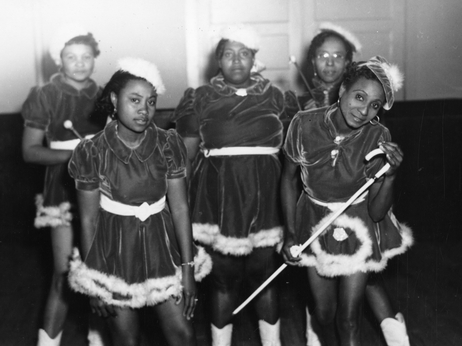The 'Baby Dolls' Of Mardi Gras: A Fun Tradition With A Serious Side

Just inside a room on the second floor of the Louisiana State
Museum's Presbytere, there's a large baby doll dress, big enough for a
woman to wear. And one did.
The costume and the baby bottle
next to it belonged to 85-year-old Miriam Batiste Reed, who was known as
a baby doll and one of the first women to parade in Mardi Gras. The
bottle and the dress are part of a new exhibition, They Call Me Baby Doll: A Mardi Gras Tradition.
"The
baby dolls are a group of African-American men and women carnival
maskers," says Kim Vaz, dean at Xavier University. "They would dress up
on Mardi Gras day in short satin skirts, with bloomers, and they would
have garters."
Vaz, who has written a new book about the baby
dolls, says the tradition dates back to 1912, when Jim Crow was the law
of the land in the South. It all started in New Orleans' red-light
district, which itself was divided along racial lines. The Storyville
area, where the sex industry was legal, was for white customers; black
customers had to go a few blocks away where prostitution was illegal,
but allowed.
"[It was] another manifestation of how Jim Crow worked to
disenfranchise black people, even in the most sordid of industries," Vaz
says.
Between these two red-light districts, there was a kind
of rivalry. One year the women in the black district heard that their
counterparts in Storyville were going to dress up for Mardi Gras; they
decided they needed to come up with some good costumes to compete.
"And
they said, 'Let's just be baby dolls because that's what the men call
us. They call us baby dolls, and let's be red hot,' " Vaz says.
Calling
a woman "baby" had just made its way into the popular lexicon, with
songs like "Pretty Baby" written by New Orleans native Tony Jackson.
There was, however, something subversive about black sex workers
dressing this way.
"At that time, baby dolls were very rare and
very hard to get," Vaz says. "So it had all that double meaning in it
because African-American women weren't considered precious and
doll-like."
Just the fact that these prostitutes were masking
and going out into the street at all was a big deal. Women just did not
do that then. And as sex workers, these women were already taboo. Vaz
says they just kept piling on by appropriating males behaviors like
smoking cigars and flinging money at the men. "If you went to touch their garter, they would hurt you," she says.
The
baby dolls carried walking sticks they would use in their dances, as
well as to defend themselves. It was about fun, Vaz says, but it was a
kind of laughter to keep from crying.
"At that time ...
residential segregation was practiced, job discrimination was practiced
[and] women didn't have the right to vote," she says. "The one way that
they could make a statement was through their dance and their dress and
their song. It's when you've exhausted all your legal remedies that you
have to use the culture to make a statement and express yourself."
They
came up with their own dance step they called "walking raddy." Pretty
soon, women in more "respectable" neighborhoods started masking baby
doll. But desegregation in the 1950s allowed black New Orleanians to do
more on Mardi Gras.
Then Interstate Highway 10 was built
directly through the neighborhood where African-Americans gathered to
celebrate carnival, disrupting many traditions. The baby dolls faded,
until several years ago.


No comments:
Post a Comment